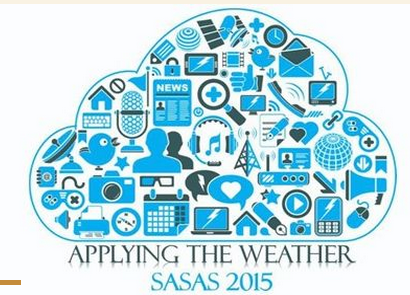South African Society for Atmospheric Sciences (SASAS) organizes an annual conference, and this year, the event precipitated on the deep outskirts of Pretoria over 21-22 September. What sets this year apart is that, although officially attached to University of Pretoria, it was organized by a cross-institutional organizing committee composed entirely of women.
The conference is usually attended by a 30-odd scientists, and 30 or so students, mostly from the main South African institutions dealing with atmospheric science: UP, CSIR, SAWS, ARC, UCT, NWU. CSAG was represented this year by two Honours students and two researchers.
The atmospheric science community in South Africa is rather small, and the scientists have a high revisit frequency and know each other for years – so the conference has a rather homely, sort of “family reunion” feel. The students, on the other hand, are mostly on a one off show, as few will stay in “circulation” by getting employed in academia or research institutes. However, I must admit that watching the students present, reading their posters, and providing some feedback makes the participation very rewarding indeed.
Since the conference is of atmospheric science, which does not equate climate science, the talks cover a range of topics, and it is not unusual for papers about typical climatology – forecasting and variability of climate, to follow ones addressing methodological aspects of meteorological measurements, or presenting results of air pollution studies or health implication of radiation exposure. Somewhat surprisingly, however, similarly to the last year, there were relatively few papers addressing the issue of climate change, in any context.
While it was good to learn about what other researchers and institutions in South Africa are doing, quite often, unfortunately, I had a feeling of a deja-vu. The scientific level of presentations, not unexpectedly, varied, but interestingly, the not-so-good ones were the most amusing. Three (good) talks stayed in my memory, however, apparently somewhat subjectively focused on forecasting.
Eugene Poolman from SAWS talked about Severe Weather Impact Forecasting System (SWIFS), which combines a probabilistic forecast of potential flash floods with event-specific societal and infrastructure vulnerability information to produce a forecast of impact risk.
The first element of SWIFS, Flash Flood Guidance System has been operationalized recently at SAWS. This system is based on Sacramento hydrological model set up for a set of small ~50km2 catchments covering South Africa (something between the quinary and quaternary catchments of Schulze). That model is first used to simulate near real time soil moisture status based on the observed rainfall. Subsequently, and 18-hours lead time ensemble forecast from the SA-version of the Unified Model is used to determine probability of flash flood. The system is targeted at forecasters and not general public, and it is apparently well integrated into South Africa’s early warning disaster management systems. Currently, Regional FFGS covering the SADC countries is being implemented. It’s a very neat and impressive system, although the excitement is somewhat dampened by the realization that the hydrological part of it is an off-the-shelf solution purchased from an US institution.
The second part of the SWIFS, the Impact Model is based on social and structural vulnerability indicators, such as population, age, poverty index, schools, hospitals, mapped at meso scale (again ~50km2). These indicators are appropriately weighted and collapsed to represent several levels of vulnerability. That vulnerability is then merged with likelihood of flash flood to produce probabilistic risk statements – information that supports decision making of disaster managers. Eugene promised that once the teething problems of SWIFS (such as uncertainty about vulnerability indicators) are solved, it will be embedded into Impact-based Severe Weather Warning System for SA.
Florian Pappenberger from ECMWF was showcasing their short-to-seasonal forecasting system, illustrating recent developments, as well as a range of “downstream” applications. The new ECMWF model cycle introduced in May 2015, incorporates improvement in observation assimilation and modelling of atmospheric processes (some changes in convective parameterization which I did not fully understand), and these lead to marked improvements to (both short term and seasonal) forecast performance, particularly in cloud cover and precipitation. The applications of forecasts showcased by ECMWF cover a range of products related to floods, wildfire, drought, malaria, wind storms and cyclones. Unfortunately, these products are mostly project-based, and not core-funded, and as a result, most of them are not operationalized, or run only for illustration purposes. The important message emerging from this talk was that ECMWF is changing the approach to distribution of their forecasts: the new improved version of forecasts (and reanalyses) will be under open access. The data should be available within the next 3-4 months. Additionally, a data portal is created, jointly with 10 international partners, supporting multi-model comparison of sub seasonal to seasonal forecast (S2S) to help researchers study predictability at these time scales.
Finally, one of the students, Lerato Mpheshea from CSIR talked about the outlook for 2015/2016 El Nino. She presented analysed of results of forecast runs of one of the GFDL models. The model has apparently a very good skill, particularly at a couple of months lead times. This led Lerato to give a series of unabashedly confident statements about the forthcoming season. And this is when youthful innocent belief in models and science met judicious restrain mixed with a dose of cynicism of experienced (read: older) part of the audience. I’m not sure who held higher moral ground at the end…
And to close on a positive note – congratulations to UCT Atmospheric Science Honours student Coleen Middleton who won the award for the best student’s poster with her “Investigating severe convective storm environments over southern Africa” study. Hopefully her success will encourage UCT students and next year will see more of them at SASAS, particularly that grapevine says SASAS 2016 will be organized by CSAG and held in Cape Town.
